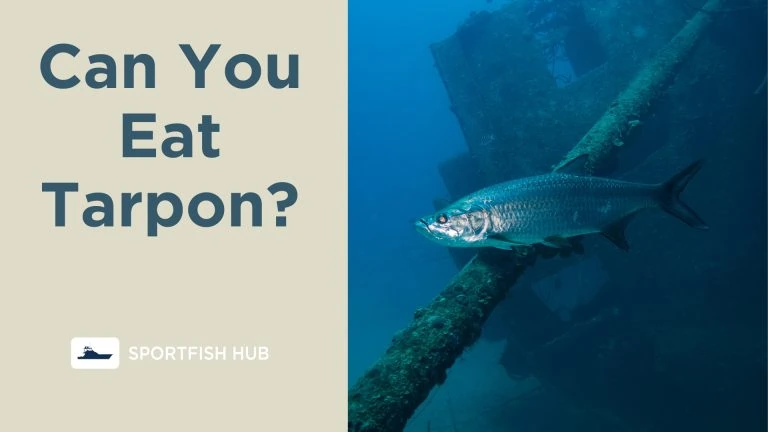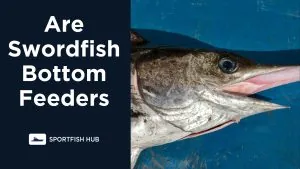Tarpon, often caught for sport by saltwater anglers, are usually quickly released back into the water. This often raises the question: “Can you eat Tarpon Meat?”
In this comprehensive guide, we’ll debunk common myths surrounding tarpon’s edibility, delve into traditional and innovative cooking methods, and provide expert insights to help you make the most of your tarpon catch.
Key Takeaways
- Tarpon is completely edible despite having a reputation as inedible. It just requires special preparation.
- Cook tarpon thoroughly to at least 145°F internal temperature to eliminate health risks. Limit consumption due to potential mercury accumulation.
- Debone tarpon carefully after poaching or simmering to help separate the flesh from the intricate bone structure.
- Traditional cooking methods include grilling, making ceviche and fishcakes, and using in soups and stews.
- Modernist techniques like sous vide, smoking, and curing can impart delicious flavor.
- Robust marinades and seasonings balance out tarpon’s strong natural flavor.
- Tarpon has a dense texture and very fishy, robust flavor. It can make for an interesting meal, but is not for everyone.
Table of Contents
- Key Takeaways
- Is Tarpon Edible? Debunking Common Myths
- Tarpon Fishing: More Than Just a Game
- How to Safely Prepare Tarpon for Eating
- Tarpon Deboning Guide: Step-by-Step Instructions
- Traditional Tarpon Recipes: From Grill to Plate
- Innovative Cooking Methods to Eat Tarpon
- Expert Tips for Cooking Tarpon: Chef Insights
- Is Tarpon Worth Eating? The Final Verdict
- Why Every Angler Should Try Cooking Tarpon
- Must-Have Tools and Recipes for Cooking Tarpon
- Share Your Tarpon Cooking Experience with Us
Is Tarpon Edible? Debunking Common Myths
Tarpon has a reputation as a foul-tasting fish with a strong odor not meant for eating. However, this perception is misguided. Tarpon is completely edible if cleaned and cooked properly. Here are some common tarpon myths debunked:
- Myth: Tarpon fish may be poisonous.
Fact: Tarpon does not contain any toxins and is safe to eat. However, as a large predator it can accumulate mercury, so consumption should be limited. - Myth: Tarpon is too bony to eat.
Fact: Tarpon does have a lot of bones, but the bones are large and can be removed relatively easily after cooking. The flesh is tender and flaky when properly prepared. - Myth: Tarpon tastes bad.
Fact: Tarpon has a robust, savory flavor. While it may not be as mild as some fish, the taste can be delightful when complemented by the right seasonings and cooking techniques. - Myth: The meat is slimy and oily.
Fact: The meat has a smooth, dense texture similar to swordfish or shark. Properly cooking tarpon results in firm, flaky fillets that are not overly oily or slimy.
In summary, fresh tarpon that is carefully handled, cleaned, and cooked makes for a unique and tasty meal. It simply requires some special considerations.
Tarpon Fishing: More Than Just a Game
Tarpon are targeted by many anglers sport fishing due to their large size, strength, and intense battle when hooked. However, tarpon fishing can also provide meat for the table. Two species are targeted:
- Atlantic tarpon: Found along the eastern seaboard and Gulf of Mexico. They migrate seasonally and congregate in inlets and river mouths to spawn.
- Pacific tarpon: Inhabit coastal waters and estuaries from Southern California down to Peru. These fish are larger on average than the Atlantic variety.
While special regulations may apply, keeping a tarpon for eating within legal limits and season is an option for anglers. Smaller juvenile fish around 25-60 lbs are best for eating. Remember to consult your local fishing guidelines.
How to Safely Prepare Tarpon for Eating
When preparing tarpon, there are some important safety considerations:
- As a large, long-lived predator fish, tarpon can accumulate mercury. Limit consumption to 1-2 meals per week and avoid eating large specimens.
- Thoroughly cook tarpon to an internal temperature of at least 145°F to kill any parasites or bacteria. Undercooking can cause foodborne illness.
- Debone tarpon completely and carefully check for any stray small bones when eating as they can pose a choking hazard.
- Clean the fish promptly after catching and keep chilled to minimize risk of spoilage. Discard any fish that smells overly fishy or has an off odor.
Following safe handling procedures and cooking tarpon thoroughly mitigates potential health risks and allows you to enjoy your catch safely.
Tarpon Deboning Guide: Step-by-Step Instructions
Tarpon have a complex bone structure that requires diligent deboning. Here are step-by-step instructions:
- Cut the fillets off the bone structure. Make long cuts close to the spine to maximize flesh.
- Simmer the fillets in broth, tomato sauce or wine until cooked through and the meat flakes easily. This makes the bones easier to detach.
- Spread a fillet on a cutting board. Run your fingers over the surface to feel for bones. Use needle nose pliers to grab any exposed bones and pull gently to remove them.
- For bones embedded within the flesh, use a filleting knife to cut into the meat and cut carefully around them to lift them out.
- Check the fillets thoroughly, feeling for any remaining pin bones or rib bones. Cut around them to remove.
- Once deboned, the fillets can be portioned for use in recipes. Chunks of flesh work well for stews, soups and fish cakes.
Take your time with the deboning process. Poaching before hand allows cleaner removal of the bones.
Traditional Tarpon Recipes: From Grill to Plate
Tarpon has been eaten by coastal and island cultures for centuries. Traditional recipes offer delicious ways to prepare your catch:
- Grilled tarpon steaks: Coat thick tarpon steaks in olive oil, lime juice, garlic, and chili flakes. Grill over high heat for 4-5 minutes per side. The char enhances flavor.
- Tarpon ceviche: Dice raw tarpon fillets and marinate in lime juice, diced onions, habanero chile, and cilantro. The acidity “cooks” the fish.
- Tarpon fishcakes: Combine cooked tarpon with mashed cassava or potatoes, eggs, herbs, hot sauce and breadcrumbs. Form into patties and pan-fry until crisp.
- Tarpon soup: Simmer tarpon head and bones into a rich broth with vegetables. Add tarpon chunks and seasonings like saffron and fennel.
- Barbecued whole tarpon: Roast a small tarpon on a spit over an open fire. Baste with a marinade of chili sauce, vinegar, garlic and spice.
Innovative Cooking Methods to Eat Tarpon
While traditional recipes are delicious, more modern cooking techniques can also yield tasty tarpon fillets:
- Sous vide: Vacuum seal seasoned fillets and cook at 135°F for 15-30 minutes, then sear quickly to caramelize exterior. Keeps tarpon moist.
- Smoking: Brine fillets overnight to increase moisture, then hot smoke for 2 hours over hickory, mesquite or applewood for robust flavor.
- Blackening: Coat fillets with a spicy dried seasoning blend. Cook in a very hot cast iron skillet briefly until charred and caramelized.
- Curing: Utilize a wet brine or dry cure of salt, sugar, and spices to firm up the flesh. Cold smoke after curing to impart extra flavor.
- Ceviche: “Cook” diced raw tarpon chemically using citrus juice or vinegar. Let marinate 1-2 hours until fish turns opaque and firm.
Don’t be afraid to get creative with preparation methods to turn your tarpon catch into a culinary treat.
Expert Tips for Cooking Tarpon: Chef Insights
Professional chefs provide their best tips for working with tarpon:
- “Tarpon needs equally strong flavors to stand up to it. A robust marinade with garlic, citrus and chili peppers is perfect.”
- “Smoke, cure, or grill tarpon. High heat methods give the best texture and avoid sliminess.”
- “Try using tarpon in fish stew or tacos where you can balance the flavor with lots of herbs and spices.”
- “Tarpon is extremely high in omega-3s and protein. But limit intake due to potential mercury accumulation.”
- “Some cultures prize tarpon for its unique taste. Be open-minded and creative with preparation to make it tasty.”
- “Tarpon’s dense meat holds up well to pasta sauces. Use it in place of swordfish or shark in robust tomato-based pasta dishes.”
Leveraging the experience of those familiar with cooking tarpon helps you get the best results with this unique fish.
You might also want to read: Why are Tarpon Protected?
Is Tarpon Worth Eating? The Final Verdict
Tarpon has a robust, savory flavor with a moderate oiliness and smooth dense texture when cooked properly. It has a stronger taste than many popular game fish like tuna or halibut. The copious small bones require diligent deboning and inspection when eating.
While not for everyone, tarpon can make for a memorable meal for adventurous eaters. Complementary marinades and seasoning help balance its flavor. Tarpon responds best to high-heat quick cooking methods or long poaching. Trying tarpon broadens the culinary palate.
For the determined angler, transforming one’s trophy catch into a memorable dinner warrants the effort. With careful prep and an open mind, tarpon is a fish worth eating.
Why Every Angler Should Try Cooking Tarpon
Cooking your tarpon catch allows you to fully experience the results of landing this prized game fish. The process of filleting, deboning, marinating and cooking transforms a fishing trophy into a unique meal to remember. While not everyone may enjoy tarpon’s particular texture and flavor, preparing it yourself provides satisfaction and a good learning experience for any angler.
Must-Have Tools and Recipes for Cooking Tarpon
To fully prepare tarpon, it helps to have the right tools on hand:
- High-quality flexible fillet knife to remove flesh from bones
- Kitchen shears for snipping bones
- Needle nose pliers to grab pin bones
- Non-stick pans for frying fish cakes
- Grill basket or cedar plank for grilling steaks
- Vacuum sealer for sous vide cooking method
Check out these tarpon recipes for cooking ideas from the Florida Fish and Wildlife Commission website.
Share Your Tarpon Cooking Experience with Us
Have you cooked up your tarpon catch into a tasty meal? We’d love to hear how it went! Share your cooking tips, pictures, or favorite tarpon recipe in the comments below. Learning how others have succeeded in preparing this unique fish will help the fishing community make the most of their tarpon catches.
You might also want to read: Why are Tarpon Protected?
Citations:
https://onthegas.org/food/tarpon-recipe-prepare-eat-tarpon/
https://www.reddit.com/r/Fishing/comments/xbwfcx/can_i_eat_tarpon/
https://youtube.com/watch?v=_-MD6y3jHac
https://youtube.com/watch?v=wg9BfVdYPjQ
https://www.floridavacationhomes.com/tarpon-fishing-in-florida/












